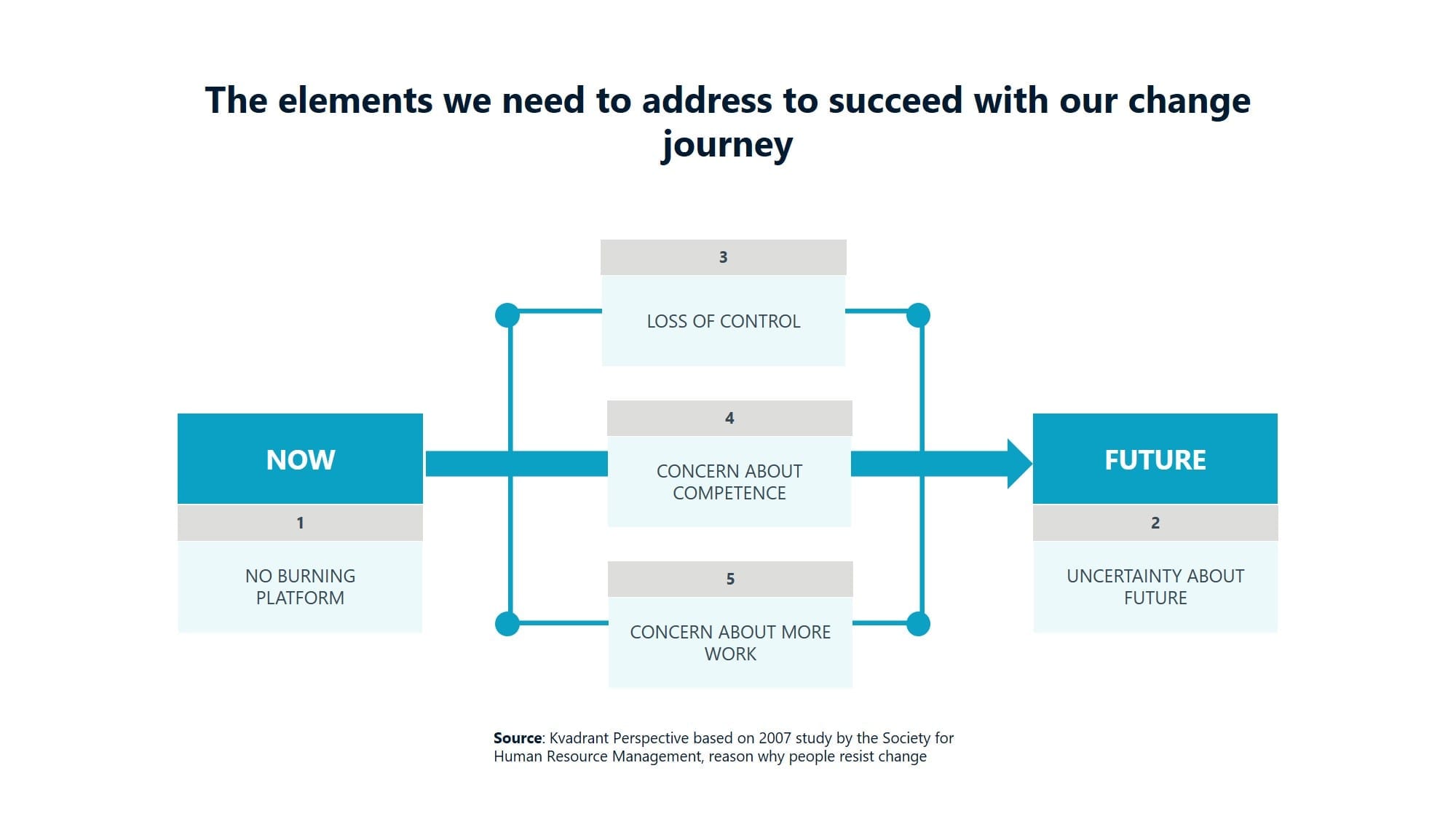Commercial leaders need to succeed with many things, but one in particular; Profitable growth.
In a B2B context, one of the key transformation levers they are pulling to achieve this, is the transformation of the sales force from field sales heavy (selling primarily through face-to-face meetings) towards increased adoption of inside sales (selling primarily through virtual and digital interactions).
The growth case: In 75% of buying situations, B2B buyers now prefer not to meet with vendors face-to-face (Sales Benchmark Index). If you want to win the customer interactions you need to be where they take place
The profitability case: Inside sales deliver 40-90% lower customer acquisition cost compared to traditional field sales (HBR). If you want to improve sales efficiency you need to adopt new ways of selling
Exhibit 1
While the transformation towards increased adoption of inside sales is business critical it is also challenging. It involves a high degree of change to the existing sales force structure and how they have been used to work:
- Shifts in power, from changes in account and deal responsibility
- Shifts in capability requirements, from changes to the selling process from physical and phone to virtual and digital (as demonstrated during the Covid-19 lock down)
- Shifts in privileges, from changes in perceived work benefits of working as a B2B salesman (company car, mileage money, corporate travels etc.)
B2B buyers demand that companies succeed with the transition and commercial organisations need to succeed with transition in the short run (fix inability to meet with buyers today) and the long run (transforming the way they sell).
To succeed with the transformation beyond COVID-19, a commercial leadership must do 3 things:
- Create the burning platform for change using own industry and customer data
- Transform in incremental steps (not as a large-scale transformation)
- Proactively address the dominant concerns in the existing organization
1. Create the burning platform for change using own industry & customer data
The burning platform for transitioning the sales force towards more digital & virtual ways of selling is clear to most commercial leaders with topline responsibility: B2B buyers demand new ways of engagement and we don’t deliver our competitors will capture them instead.
Example: A study by MIT and Insidesales.com demonstrated that the odds of converting a marketing captured lead into a qualified sales opportunity decreases 600% within the first hour. If sales organisations are not set up for rapid lead response management the business goes to competitors who are
If it wasn’t clear before Covid-19, it very quickly did once the possibility for face-to-face meetings was removed completely.
But for field sales people who have worked for years in the face-to-face model, the burning platform for change is less intense. Many will argue that their customers still want physical meetings through visits, although the overall data suggests otherwise (i.e. in 75% of buying situations, B2B buyers don’t want to meet face-to-face).
To create the burning platform for change, the commercial executive needs to make the case for change in their specific business context, with data the sales organization trusts (instead of broad general research as used in this article)
Take Action:
- Collect industry data: How is buying behavior changing in the specific industries your company serves and how is this expected to develop going forward (desktop research)?
- Get the customer perspective: In which buying situations (different types of transactions and stages of the purchasing process), would your buyers be open to new ways of engagement and where do they demand it (survey and interviews)?
- Involve sales leadership in making conclusions: Based on new knowledge about changes in our industry and buyer preferences, how do we need to change the way we sell? (Guided workshops)
2.
Transform in incremental steps (not as a large-scale transformation)
Inside sales has potential to deliver sales efficiency and effectiveness gains in many places:
- As a prospecting engine (The Hunter)
- As a lead management engine (The Responder)
- As a full funnel sales person (The Closer)
- As a supporter for field sales reps (The Supporter)
- As an account manager responsible for customer success (The Developer)
Exhibit 2
Although you may end up applying all 5 roles to your commercial organization, the transformation towards better use of digital & virtual selling should happen incrementally.
Build the capability bit-by-bit.
Example: A European utility company, whose target customers were predominantly located in remote areas far from major cities, found that their target buyers had increased digital activity and opened up to the possibility of engaging virtually rather than through physical meetings. The company had no prior experience working with inside sales, so a pilot team of 4 inside sellers was set up to prospect for leads (Hunters) in Sweden and the UK for 5 selected segments. After the new function demonstrated ability to generate sales qualified leads for the consultative sellers in these industries and markets, it could be expanded to take care of other tasks (e.g. lead response management), for other industries and markets.
The best way to demonstrate the business case for increased use of virtual & digital selling is through the company’s own numbers, by running an “experiment”, to test if the shift has potential to generate value. Once ability to generate value has been demonstrated, it can be scaled.
Exhibit 3 
3. Proactively address dominant concerns in the existing sales organization
Changing the way you sell (towards increased use of digital & virtual selling), is difficult because it involves changing long-standing structures and processes in the sales organisation.
From few but long sales meeting through customer visits, to many but shorter sales meetings through virtual channels
Asking the existing sales force to adopt new ways of customer engagement, and trade customer visits for virtual meetings, is easy now that face-to-face meetings are virtually impossible.
They have no choice but preventing them from going back to previous ways of working (where it does not make economical sense, from the perspective of the company), is difficult for 3 reasons in particular:
- Loss of control: Sales people may find the skills that made them successful field sellers does not work when working as an inside sales person. Frustration of not being good at what they do sets in and they revert to old ways of working when possible
- Loss of privileges: Sales people may find that they loose economic & perceived benefits, such as company car, mile-money or corporate travels, when shifting towards an inside sales role. Personal incentives will steer them towards old ways of working.
- Loss of status: Sales people may find that they feel a loss of status, now being perceived as a “phone-seller” rather than a “road-warrior”. The identity they get from being on the road, visiting customers will steer them back in the car and back on the road.>11% of companies operate at this level.
Exhibit 4

Some sales people will not be able to make the shift towards greater adoption of the inside sales role, for the reasons outlined above.
Sales managers, responsible for their individual teams, play a huge role in proactively addressing these concerns in the organisation and helping people move beyond them.
- Coach on new skills: Conduct frequent skills coaching sessions based on observations, to help seller improve ability to work as an inside seller
- Change incentive structure: Working as an inside seller offers great potential for the sales person like ability to close more business (more efficient) or avoiding travel time (more time with family). Make sure there is a clear upside in incentives for sales people to make the shift.
- Make inside sales a career path: Working as an inside seller doesn’t need to be a stepping stone towards field sales, it should be a career path on it’s own. Give people the possibility to progress either into a manager/coaching role or as an account executive (AE) on large deals and accounts, managed primarily through virtual contact.
Commercial leaders need to succeed with many things, but one in particular; Profitable growth and shifting the sales force towards increased use of inside seller (using virtual and digital means of engagement) is a key lever to pull, to achieve this.
Covid-19’s implications for how the B2B sales force has typically operated is clear: Can’t meet with the customer. This is the burning platform commercial leaders can now use to accelerate the transition from a field sales heavy way of working towards a more balanced use of digital, virtual and physical touch point with customers.



